
Rivers are the roads of the rainforest. There are more than one thousand rivers in the Amazon rainforest! Anyone venturing into the region will likely need to cross or travel on a river.
The best way to navigate an Amazonian river is to walk alongside it. There are often trails made by animals or people. Following these trails downstream for as long as possible, especially along a well-worn path, will bring you closer to people.

What if the trail ends or there is an obstacle.? You may need to cross the river, or even travel in the water to keep heading downstream. But what dangers lurk beneath the surface?
You’d think that lots of people would have traveled the entire length of the Amazon by boat. But, actually, only a few people have been able to do it successfully.
In August 1985, Polish kayaker Piotr Chmielinski was the first person to make it down the length of the Amazon under his own power. Chmielinski was part of an expedition that began in the mountains of Peru, at what was then thought to be the Amazon’s source. Chmielinski did his whole journey in a kayak, reaching the mouth of the Amazon six months after he started.
Crossing a river can be dangerous. All rivers have a current. The current can be barely noticeable, or it can be strong enough to pull you rapidly downstream. A river can get deep very quickly as you head toward the middle. Currents are always stronger in the middle of a river than at its edges. Here are some good rules to follow if you want to cross a river:
WORDS TO KNOW
kayak: a light, narrow canoe useful for traveling in fast currents.
upstream: against the direction of a stream’s current, toward its source.
balsa: a tropical tree with very light wood that floats.
tannins: substances found in plants that are used to turn animal skins into leather.



There are three types of rivers in Amazonia: blackwater, whitewater, and clearwater. Blackwater rivers originate in the lowlands. They flow through swamps and flooded forests. They are full of acidic soil and sand, and are usually the color of dark tea. Their color comes from the tannins of decaying leaves and debris. Strangely enough, blackwater rivers have some of the purest water on Earth.
Whitewater rivers begin in the Andes Mountains. These mountains are young, tall, and crumbly. So rock, dirt, and minerals easily wash off them into whitewater rivers. Whitewater rivers have lots of plant and animal life, and are a creamy yellow color.
The clearwater rivers come from ancient parts of what is called the Brazilian and Guayana shield—earth that is low, old, and already very broken down. Not a lot of minerals or nutrients come into these rivers, and there is not a lot of plant life here.

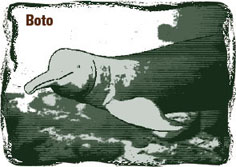
Imagine an otter the size of an adult man—6 feet (2 meters) long or more—and weighing up to 70 pounds (about 32 kilograms). This is the size of the giant river otter, the largest and most endangered species of otter in the world.
Giant river otters are known as the wolves of the river, because they hunt in packs and are fearless. They will take on prey much larger than they are, including giant anacondas and caimans. In fact, it is the otters’ fearlessness that has helped make them so endangered. Instead of running away from hunters, giant river otters swim right up to the hunters’ canoes to intimidate them. This makes them easy to kill. Giant river otters have velvety-soft fur, making their pelts very valuable.
Since the late 1980s it has been illegal to hunt the giant river otter, so the wolves of the river may make a comeback.
The Amazon’s flooded forests are home to one of the most amazing animals on earth—the Amazon River dolphin. Known as the boto, the Amazon River dolphin is a freshwater mammal that grows up to almost 9 feet (3 meters) in length, weighs 400 pounds (182 kilograms), and is bright pink!
People who live in Amazonia believe that when someone drowns in the river, their spirit enter the bodies of the botos. These dolphins are said to have magical powers. At night, the botos come to visit people in the shape of handsome young men. If you meet up with a mysterious, handsome stranger at night, beware—it could be a boto in disguise!
Calm water is easier to cross than running water, but it also has hidden dangers. If you were crossing a calm bit of water in the Amazon, you might suddenly notice that there were lots of sticks and branches beneath you. You would probably think that these sticks and branches are from fallen trees, but they might be from something else. One of the most fascinating things about the Amazon are its flooded forests—you might be swimming above trees that are buried underwater!
During the rainy season—November to March—the rivers of the Amazon flood. When this happens, the waters often rise up to 50 feet (15 meters). Entire forests become submerged in water—sometimes for long periods of time. In some areas, forests can be covered by water for as long as 8 to 10 months of the year.
The trees and shrubs in these forests grow very quickly when the floodwaters go down. In fact, scientists recently learned that the Amazon rainforest actually grows more in the dry season than it does in the wet season. This is exactly the opposite of what happens elsewhere.
—FASCINATING FACT—
At the Meeting of the Waters in Manaus, Brazil, the Rio Negro (a blackwater river) and % the Rio Solimoes (a Whitewater river) meet but don’t mix for more than 50 miles (81 kilometers). Instead, the two rivers flow side by side, one dark brown, the other creamy yellow, until the dark waters are finally absorbed into the Amazon River.

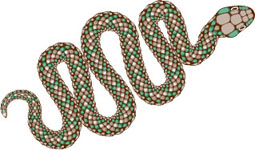
Flooded forests are the cafeterias of the rainforest. When the floodwaters rise over the land, they help add nutrients to the forest soils, lakes, and floodplains. Lots of fish and other creatures migrate to the flooded forests every year to find food and shelter in the treetops. In fact, many fish eat fruit from trees that in the dry season would be thirty feet above the ground! They swallow the fruit whole and pass along the seeds as they swim. The seeds then go elsewhere in the river, take root, and begin to grow into new fruit trees.
Other fish, such as the tambaqui, have very strong teeth good for cracking and eating fruits and seeds that fall from the tops of trees. The tambaqui wait under the trees for the fruit to ripen. When the fruit falls and hits the water, the fish feel the vibrations and come to the surface to eat.

Sometimes a river or lake is just too wide to swim across. In order to cross, people in the Amazon have to build rafts. But what do they make them out of? How could you make a raft?
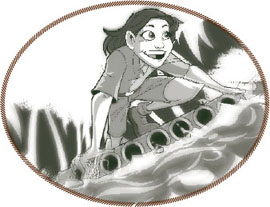
While balsa wood makes the best rafts, bamboo works well, too. People have used bamboo for centuries to make sturdy rafts for travelling on the rivers of Amazonia. Like balsa, bamboo is easy to find and it is light and strong, and floats well.
You need six stalks of bamboo about eight feet long. With a knife, notch out windows (holes through the bamboo) on opposite sides of the bamboo on both ends of the poles. Line up the windows of the poles so you can push another bamboo pole through, and lash the cross pole to the raft using flexible liana vines. If you want extra buoyancy, make a second layer of bamboo poles with one less pole so the bottom layer has six poles and the top layer has five. Lash the two layers together. Your raft will ride higher in the water. The lianas—or any rope—you used to tie the raft together will fray pretty quickly when the raft is on the water. You would want plenty of extra liana coiled on the raft for repairs.
—FASCINATING FACT—
Trees in the flooded forests usually have bark that is covered in thick, cork-like tissue that protects it from the water. The tree’s leaves are protected by a water-repellent covering.
Believe it or not, in some parts of the Amazon the biggest danger isn’t from big cats or snakes—it’s from honeybees! While they normally won’t bother people, they can be very aggressive if their nests are disturbed.
You can’t outrun honeybees, but you can outswim them. If you disturb a honeybee nest and you are near water, the best thing to do is dive in and swim underwater as far as you can. Then try to come up under some vegetation, like tree branches. If you aren’t near water, try to hide in the thickest brush you can, so the bees have a hard time flying in to sting you. The best way to avoid being attacked by a colony of honeybees is to follow the S’s: move slowly, speak softly, and don’t stink (they can smell you!).

Lots of creatures live in the mud and muck at the bottom of Amazonia’s rivers and streams, including freshwater stingrays. Stingrays have a very sharp barbed tail that they whip up if they feel threatened. The stingray’s barb carries a very painful poison. The poison isn’t deadly, but it definitely hurts a lot!
Another animal found in the Amazon’s rivers and streams is the electric eel. Despite its name, the electric eel isn’t actually an eel at all. It’s a freshwater fish that lives in slow-moving waters. The electric eel can grow as long as 8 feet (2½ meters). It kills its prey by shocking it with an electric charge. Some of the shocks are strong enough to kill a horse!
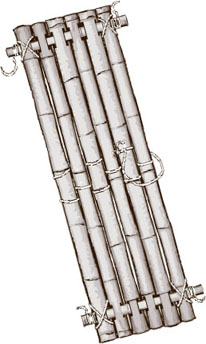
Another thing to watch out for in the Amazon is quicksand. Quicksand isn’t actually sand, it is soil that has become so wet that it can’t hold any weight. During the rainy season, the ground in Amazonia is wet almost everywhere, especially near lakeshores and riverbanks.
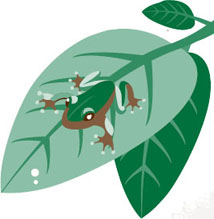
Quicksand isn’t a bottomless pit, and you aren’t going to drown in it—don’t believe the movies! It’s usually just a couple of feet of sticky, gooey, sucking mud or sand.

But it can still be tricky to get free from it. What usually happens to people when they step in quicksand is that one of their feet will sink first. Then they shift their weight onto the other foot to try to pull the first foot out, and end up with both feet stuck.
If you were ever to find yourself stuck in quicksand don’t do this! Instead, you should fall forward onto the quicksand. This distributes your weight more evenly over a larger surface. Then slowly pull your whole body forward so your feet come free. Don’t stand up and have the same thing happen all over again. To keep moving through quicksand, stay low and crawl through it.
The easiest raft to build is a one-person seat raft. You can build a seat raft out of wood that floats well. Or if you just want to have fun, use a foam noodle. Cut the noodle in half so you have two equal lengths. Tie the noodles together at both ends with rope. Leave enough space between the noodles so you can sit in between them with one noodle under your knees and the other noodle behind your back. The seat raft will keep you above the water and let you guide yourself with your legs.

A fish that frightens people even more than the piranha is the tiny candiru. These small river catfish are also called toothpick fish because they are so thin. Candirus are almost impossible to see because they are transparent. There are only a few rivers in the Amazon that contain candiru. The candiru is a parasite, which means it lives in or on another animal and feeds off it. For example, candiru will swim into the gills of fish when the fish exhales. The candiru attaches itself to the inside of the fish and sucks its blood.
So why would a little fish like the candiru frighten people? Because people say that candiru are attracted to human urine and will swim up your urine stream and lodge itself inside your body. So if you have to go to the bathroom, don’t do it in a river in Amazonia!

WORDS TO KNOW
buoyancy: the force that makes something able to float.
anaconda: large constrictor of tropical South America, usually found living in swamps or slow-moving water.
Among the animals that live in the slow, stagnant waters of Amazonia’s lakes and swamps are some of the most fascinating and rare creatures on Earth. They can also be very dangerous. But most of them view you as the predator, not the other way around.
Anaconda: The anaconda is the world’s biggest snake. It isn’t the longest—that honor goes to the Asiatic reticulated python—but the anaconda can grow to almost 30 feet (9 meters) long and can weigh up to 550 pounds (250 kilograms). This makes it the world’s most massive snake.
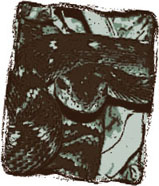
The anaconda preys on animals such as fish, capybaras, tapirs, caimans, deer, and even jaguars. Anacondas are slow-moving predators that hunt by stealth. They can stay underwater for 10 minutes at a time, waiting for their victim to come close enough to attack. The anaconda bites its prey and holds the animal in its jaws until it can coil itself completely around the body and squeeze it to death. Then the snake swallows the animal whole
It is pretty unlikely that you’ll run across an anaconda in the Amazon, though. They are very wary of humans. Unless they are actively hunting, anacondas will avoid any confrontation. You may be lucky enough to see an anaconda sunning itself in tree branches or lying on the bank of a shallow, slow-moving river.

Caiman: Caimans are part of the alligator family. They are the largest freshwater-based predator in the Amazon River basin. There are many different species of caiman, ranging from the dwarf caiman, which grows to about 4.5 feet, to the enormous black man, which can grow as long as 20 feet (6 meters). Caimans usually live near riverbanks, where they build large, mounded nests in which they lay up to 40 eggs during the dry season Caimans are night hunters. They eat fish and larger animals that go in or near the water, such as capybara, other mammals, and sometimes even humans. The safest way to deal with caimans is to avoid them altogether. Only go in calm water during the day.
—FASCINATING FACT—
Caimans have extremely strong jaw muscles for clamping down. But the muscles for opening up their mouths are quite weak. You can easily hold the jaws of a caiman together using only your hands.
WORDS TO KNOW
caiman: a reptile that’s very similar to an alligator. It lives in Central and South America.
manatee: a large, plant-eating mammal that lives and swims in the Amazon and other parts of the world, including India and Florida.
stillwater lake: a lake within the boundaries of a wetland, often surrounded by swamp-like plants and habitat.
wetland: a low-lying area that is filled with water.

Piranha: The piranha is the Amazon’s most famous fish. They are carnivorous, which means they eat meat. Piranhas are attracted to thrashing movements and the smell of blood. They attack their prey with fierce, sharp nips. Their razor-sharp teeth can gouge out chunks of flesh from their victims. The blood from these cuts attracts more piranhas, and they can have what is called a feeding frenzy, snapping at everything around them. People have seen a school of piranhas in a feeding frenzy strip a large animal down to its skeleton in less than 15 minutes.

Piranhas have a scary reputation from the movies, but the truth is that they usually don’t attack humans. However, if food is scarce and you happen to be bleeding, piranhas will bite first and ask questions later.
—FASCINATING FACT—
Predators such as caimans and piranhas view lots of splashing and noise as signs of an injured animal. Injured animals usually make easy hunting.
So if you swim, do it slowly and calmly. Don’t splash or make a lot of noise, and definitely don’t go in the water if you are bleeding.

One of the most amazing animals in the rainforest is the Amazonian manatee. It is the largest mammal found in the waters of the Amazon River basin. The Amazonian manatee can grow as long as 9 feet (3 meters) and weigh as much as half a ton. This is 1,000 pounds (454 kilograms)! However, it is still the smallest species of manatee.
All manatees are vegetarians. During the wet season, these gentle creatures eat water hyacinth and water lettuces that grow in and around the stillwater lakes of the wetlands. In the dry season, they head to deep river channels where they live together in groups of up to eight manatees. There has been a hunting ban on manatees since 1973. But river dams make it hard for manatees to migrate. These dams have seriously reduced the numbers of manatees living in the Amazon today.